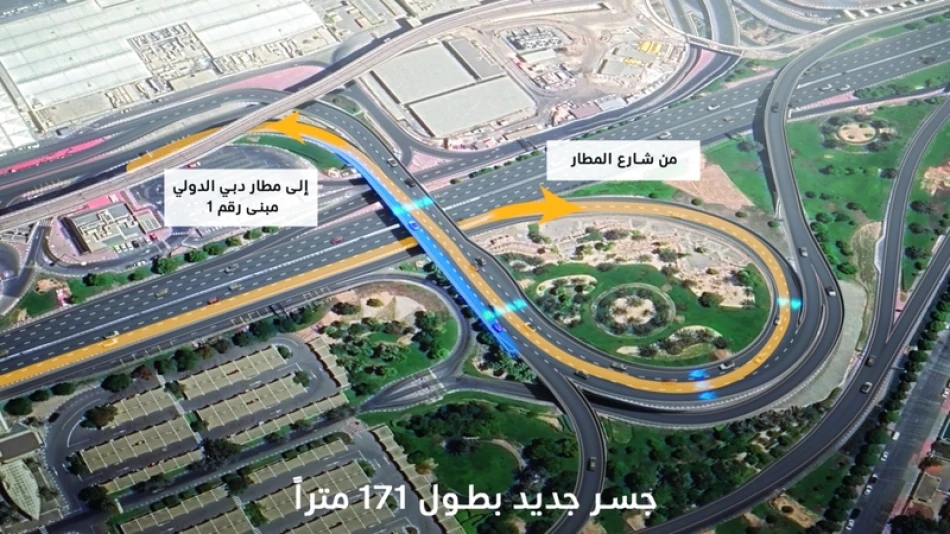
Dubai Roads Authority Secures Contract for Dubai International Airport Terminal 1 Expansion Project
Dubai Doubles Down on Airport Infrastructure as 92 Million Passengers Test Capacity Limits
Dubai's Roads and Transport Authority has awarded a major contract to expand the bridge leading to Terminal 1 of Dubai International Airport, responding to record passenger volumes that exceeded 92 million travelers in 2024. The project highlights the emirate's aggressive infrastructure investments as it positions itself as the world's premier aviation hub, but also reveals the mounting pressure on existing facilities from explosive growth in air travel.
Engineering Innovation Meets Urgent Capacity Needs
The expansion will increase the bridge from three lanes to four using an innovative steel box girder system integrated with composite concrete slabs. This engineering approach allows construction without disrupting existing traffic flows on Airport Road—a critical consideration given that any closure would create massive bottlenecks for the world's busiest international passenger airport.
The 171-meter bridge, including ramps, will boost hourly vehicle capacity from 4,200 to 5,600 cars—a 33% increase that should provide immediate relief during peak travel periods. However, this improvement may prove temporary given Dubai's trajectory toward even higher passenger volumes.
The Numbers Behind Dubai's Aviation Dominance
Dubai International's 92 million passengers in 2024 cement its position as the world's busiest airport for international traffic, surpassing traditional hubs like London Heathrow and Hong Kong. This figure represents not just recovery from pandemic lows, but significant growth beyond pre-2020 levels.
The passenger surge reflects Dubai's broader economic strategy of positioning itself as a global transit point between Asia, Europe, and Africa. Emirates airline's hub-and-spoke model, combined with Dubai's visa policies and business-friendly environment, continues to drive this growth.
Infrastructure Race Against Time
The bridge expansion forms part of a broader Airport Road development program that Dubai's transport authority has pursued over recent years. Previous projects included bridges and tunnels at multiple intersections, direct access routes to Terminal 3, and additional lanes on key arterial roads.
These investments mirror similar infrastructure races in other major aviation hubs. Singapore's Changi Airport has undergone continuous expansion, while Istanbul Airport was built from scratch to handle 200 million passengers annually. Dubai's approach of incrementally upgrading existing infrastructure while planning Al Maktoum International as a future mega-hub represents a different strategy—maintaining current dominance while preparing for long-term growth.
Economic Implications and Market Positioning
For Dubai's economy, airport accessibility directly translates to competitiveness. Business travelers and tourists alike factor journey times from airport to destination into their travel decisions. Any perception that Dubai's infrastructure is overwhelmed could benefit rival hubs like Doha, Abu Dhabi, or Singapore.
The 33% capacity increase may seem substantial, but with passenger growth rates often exceeding infrastructure development timelines, Dubai faces a continuous challenge. The emirate's aviation sector contributes significantly to GDP, making these infrastructure investments essential rather than optional.
Looking Beyond Quick Fixes
While the bridge expansion addresses immediate bottlenecks, Dubai's long-term aviation strategy depends on successfully transitioning traffic to Al Maktoum International Airport at Dubai World Central. That facility, designed for 160 million passengers annually, remains underutilized while Dubai International strains at capacity limits.
The timing of this transition will prove crucial. Moving too quickly could disrupt Emirates' operations and passenger convenience, while waiting too long risks infrastructure breakdown and competitive disadvantage. Other global cities have struggled with similar airport transitions—Berlin's decade-long airport debacle and Hong Kong's complex logistics in opening its new airport serve as cautionary tales.
Dubai's bridge expansion, therefore, represents more than traffic engineering—it's buying time for one of the world's most ambitious aviation strategies to unfold successfully.
 Sara Khaled
Sara Khaled







